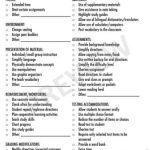Accommodations for ELL Students: A Guide to Supporting Diverse Learners

As educators, we know that every student learns differently, and this is especially true for English Language Learners (ELLs). Providing adequate accommodations for ELL students is crucial to help them access the curriculum, build their language skills, and achieve academic success. In this article, we’ll explore the importance of accommodations for ELL students, types of accommodations, and practical strategies for implementation.
What are Accommodations for ELL Students?
Accommodations for ELL students refer to the support services, tools, and strategies that help them overcome language barriers and participate fully in the learning process. These accommodations can be linguistic, cognitive, or cultural, and they’re designed to level the playing field for ELLs. By providing accommodations for ELL students, teachers can create a more inclusive and supportive learning environment that encourages socialization, creativity, and academic growth.
Why are Accommodations for ELL Students Important?
Accommodations for ELL students are essential for several reasons:
- Language barriers: ELLs may struggle to understand complex instructions, vocabulary, and concepts, which can hinder their academic progress. Accommodations help bridge this gap and enable them to access the curriculum.
- Cognitive load: Learning a new language while navigating academic content can be overwhelming for ELLs. Accommodations help reduce cognitive load, allowing them to focus on learning.
- Cultural differences: ELLs may come from diverse cultural backgrounds, which can affect their learning styles, behaviors, and communication patterns. Accommodations help teachers understand and respond to these differences.
Types of Accommodations for ELL Students
Accommodations for ELL students can be broadly categorized into three types:
Linguistic Accommodations
These accommodations focus on language support and include:
- Bilingual dictionaries and glossaries to help ELLs understand key vocabulary
- Graphic organizers to simplify complex concepts and relationships
- Visual aids, such as pictures, diagrams, and videos, to support comprehension
- Multilingual resources, including books, articles, and online texts, to provide access to native-language materials
Cognitive Accommodations
These accommodations address cognitive processing and include:
- Simplified instructions and (concise language to reduce confusion)
- Breakdown of complex tasks into smaller, manageable steps
- Visual schedules and timelines to support organization and planning
- Graphic organizers to aid note-taking and summarizing
Cultural Accommodations
These accommodations respond to cultural differences and include:
- Culturally responsive teaching that acknowledges and values diverse backgrounds
- Incorporation of diverse texts and resources that reflect ELLs’ experiences
- Group work and collaborative activities that promote socialization and community building
- Recognition of cultural events and celebrations that are significant to ELLs
Practical Strategies for Implementing Accommodations for ELL Students
Here are some practical strategies for implementing accommodations for ELL students:
Assess and Identify Needs
- Conduct regular assessments to identify ELLs’ language proficiency levels, learning styles, and academic strengths and weaknesses.
- Use this information to develop personalized accommodation plans that address specific needs.
Differentiate Instruction
- Use a range of teaching strategies, such as visual, auditory, and kinesthetic approaches, to engage ELLs and cater to different learning styles.
- Provide opportunities for ELLs to practice language skills in authentic contexts, such as role-plays, debates, and presentations.
Provide Extra Support
- Offer extra support outside of regular class time, such as tutoring, mentoring, or homework help.
- Encourage ELLs to ask questions and seek help when needed, creating a safe and supportive learning environment.
Communicate with Parents and Guardians
- Keep parents and guardians informed about ELLs’ progress, accommodations, and needs.
- Encourage parents and guardians to share their insights and experiences, promoting a collaborative approach to supporting ELLs.
Conclusion: Accommodations for ELL Students Matter
Accommodations for ELL students are crucial for their academic success, socialization, and overall well-being. By understanding the importance of accommodations and implementing practical strategies, teachers can create a more inclusive and supportive learning environment that values diversity and promotes equity. Remember, accommodations for ELL students are not a luxury – they’re a necessity for ensuring that every student has the opportunity to thrive.
<